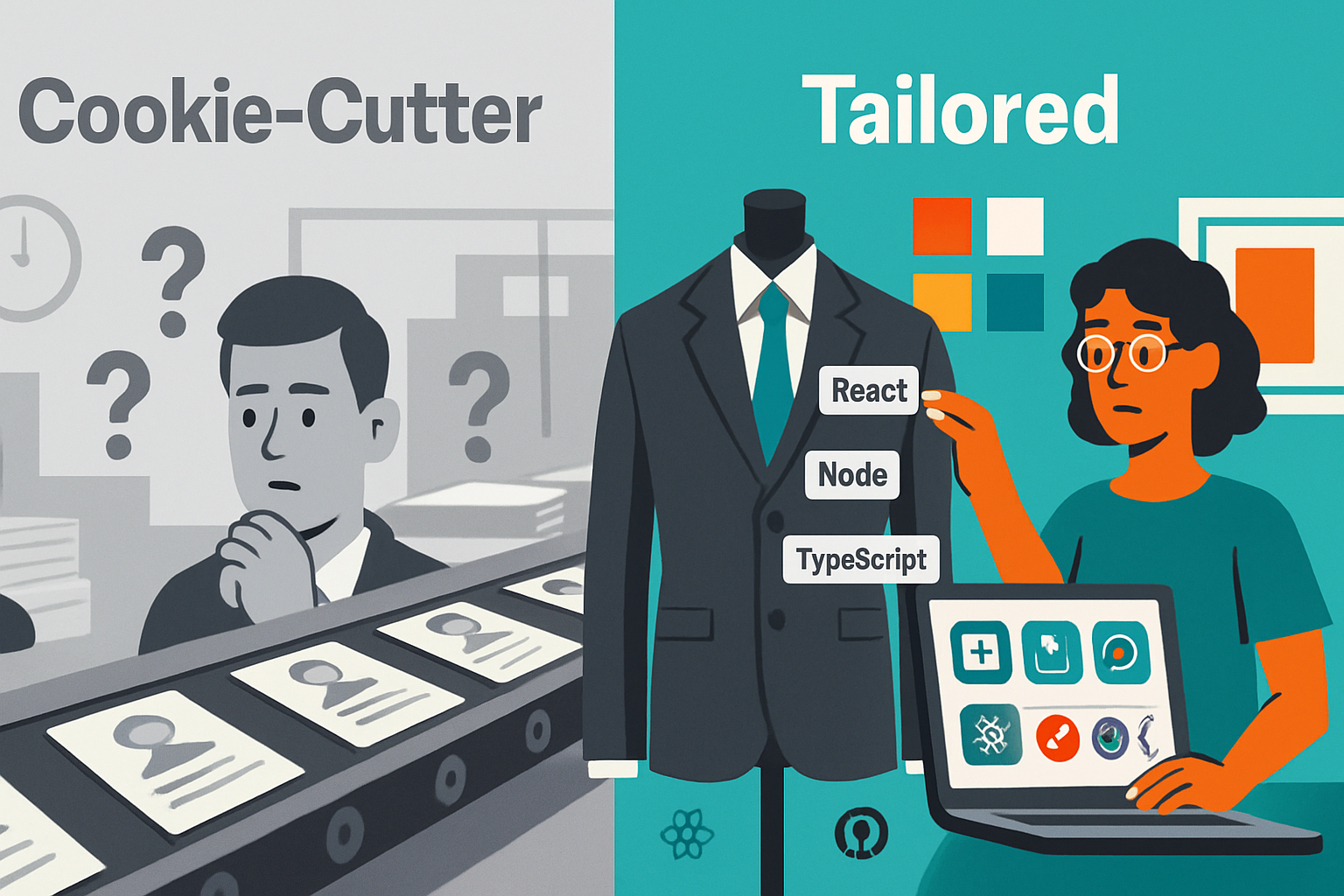· career · 7 min read
Mastering the Art of Behavioral Interviews: The JavaScript Engineer's Guide to Big Tech
Use storytelling to turn your JavaScript work into compelling behavioral interview answers. Learn frameworks, craft project-based stories, show measurable impact, and deliver technical depth without losing your interviewer.

What you’ll get from this guide
By the end of this article you’ll be able to craft and deliver 8–10 interview-ready stories from your JavaScript projects that clearly demonstrate problem-solving, collaboration, leadership, and measurable impact. You’ll learn practical frameworks, exact sentence-level structures, and several ready-to-adapt sample answers designed for Big Tech behavioral interviews.
Hook: technical skill gets you in the room. Storytelling gets you hired. Short sentence. Big truth.
Why storytelling beats reciting hobbies or vague achievements
Interviewers aren’t just grading code. They’re trying to predict how you’ll behave under pressure, with teammates, and when requirements change. A tight story communicates patterns of thinking: how you define problems, decide trade-offs, communicate with stakeholders, and follow through until the result is measurable.
Stories are repeatable signals. They let you show process, not just outcome. They let you show context and judgment. The best stories end with a clear metric and a reflection on what you’d do next.
A practical framework you can actually use: STAR (with engineering tweaks)
Most folks know STAR (Situation, Task, Action, Result). Use it, but engineer it for depth:
- Situation - one crisp sentence that sets the stage: product area, scale (users/requests), team size, and constraints.
- Task - your specific responsibility. Avoid “we” when describing actions.
- Action - the technical and interpersonal steps you took. Separate technical decisions from communication decisions.
- Result - quantitative impact, plus one concrete lesson and what you’d change next time.
For engineering interviews, add two sub-points inside Action:
- Design & trade-offs - summarize alternatives and why you chose one.
- Implementation details - one or two meaningful specifics (libraries, performance optimizations, metrics you tracked). If asked, be ready to deep-dive into code.
Resources: See a short primer on the STAR method for interview answers: https://www.indeed.com/career-advice/interviewing/star-interview-method
Preparing your story bank: what to collect from your JavaScript projects
Collect 8–10 stories that map to common behavioral themes. For each project, capture these bullets:
- Context: product, team size, and scale (users, page views, requests/sec).
- Your role: exactly what you owned.
- Problem: concise statement of the user or business problem.
- Action: decisions, code-level choices, and how you communicated changes.
- Result: metrics (load time reduced by X ms, conversion up Y%, error rate down Z%).
- Lesson: what you’d do differently.
Prioritize stories from production incidents, performance work, cross-team collaboration, mentorship, and shipping under tight deadlines. Big Tech interviewers love high-impact, cross-functional examples.
JavaScript-specific story themes (with examples)
- Performance optimization on a customer-facing page
- Diagnosing and fixing a memory leak in a SPA
- Migrating a large codebase (vanilla JS → framework, or JS → TypeScript)
- Implementing progressive enhancement or accessibility improvements
- Improving test coverage and CI for front-end code
- Ownership of a feature shipped across multiple teams (API contracts, versioning)
- Handling a production incident caused by frontend error or API misuse
- Mentoring new hires on code reviews and architecture decisions
These themes let you show both technical chops and soft skills.
Three sample STAR answers (JavaScript-focused)
Example 1 - Performance optimization (single-paragraph STAR)
Situation: Our checkout page had a 6-second first contentful paint on mobile for ~200k monthly visitors. Task: I was asked to cut the time to under 2.5s while preserving feature parity. Action: I ran RAIL-style profiling, found a large synchronous JSON parse and a blocking third-party script; split critical rendering path, lazy-loaded noncritical modules with dynamic import(), and replaced the blocking script with an asynchronously loaded, cacheable shim. I also shipped a small code-splitting change and added Lighthouse checks to CI. Result: First contentful paint dropped to 1.6s on our median device, cart abandonment fell 7% in the next A/B window, and Lighthouse scores improved by 25 points. Lesson: Add CI performance budgets earlier and limit third-party blocking scripts.
Example 2 - Memory leak in a single-page app
Situation: Users reported the tab slowed to a crawl after an hour of use in our analytics SPA. Task: I needed to locate and fix the leak quickly. Action: I reproduced the issue locally, used Chrome DevTools heap snapshots, and identified detached DOM nodes from improperly removed event listeners in a dashboard widget. I implemented a teardown() method for components, enforced subscription patterns (use AbortController for fetches and removeEventListener on unmount), and added unit tests for lifecycle cleanup. Result: The memory trend flattened to near-zero growth in long-running sessions and we avoided several escalations. Lesson: Instrument lifecycle hooks with tests and monitoring to catch leaks early.
Example 3 - Cross-team feature with API contract changes
Situation: Two teams had to coordinate a major feature where front-end expectations changed but the API remained backward-compatible for other clients. Task: I was the front-end owner responsible for the rollout plan. Action: I created a feature-flagged rollout with contract tests, authored a clear spec + example payloads, and set up a Canary release to 5% of users with observability dashboards for error rates and latency. I scheduled daily syncs with the backend team and documented fallback behavior. Result: We launched to 100% with zero customer-facing errors and reduced manual rollback risk; the canary caught a serialization bug that would have affected 20% of edge cases. Lesson: Contract tests and canary releases reduce blast radius and keep releases safe.
How to show technical depth without drowning the interviewer
- Start with a one-sentence summary of the technical decision.
- Provide 1–2 concise specifics (libraries, benchmarks, algorithms). Example: “I replaced our synchronous JSON.parse call with a streaming parser and reduced parse time by 40% on large payloads.”
- If the interviewer asks, go deeper. If they don’t, you’ve given them enough to probe.
- Use analogies when explaining trade-offs to non-technical interviewers, but be precise with numbers when asked.
A short code snippet can be useful in interviews if you’re asked for specifics. Example of an event-listener teardown flaw:
// Bad: adds listener but never removes it
element.addEventListener('resize', () => {
/* update UI */
});
// Good: keep reference and remove on teardown
function onResize() {
/* update UI */
}
element.addEventListener('resize', onResize);
// later
element.removeEventListener('resize', onResize);Prompts and language to make stories compelling
- Use first person. Say “I” for actions you owned. Avoid passive language.
- Quantify impact: percentages, milliseconds, and user counts are powerful.
- Describe trade-offs briefly: why not X? because Y.
- End with a short reflection: what you learned and what you’d change.
A tight closing sentence is your strongest finish. It turns a project recap into an indicator of future behavior.
Practice plan: 4 weeks to polished stories
Week 1: Inventory and metrics
- Pick 8–10 stories.
- Fill the bullets (Context, Role, Problem, Action, Result, Lesson).
Week 2: Draft STAR answers
- Write 2–3 paragraph STARs for each story.
- Time each answer to 60–90 seconds.
Week 3: Mock interviews
- Practice with a peer or record yourself.
- Get feedback on clarity, pacing, use of “I”, and technical depth.
Week 4: Fine-tune & tailor
- Align stories to the company’s leadership principles or values.
- Prepare 2 deep-dive tech follow-ups per story.
Common pitfalls and how to avoid them
- Vagueness: Don’t say “we improved performance” without metrics.
- Blame shifting: Avoid pointing fingers. Focus on actions you took.
- Overly technical monologues: Give impact up front; drill into details only if asked.
- Forgetting the lesson: Always end with a reflection and next step.
Interview day tactics
- Start answers with a one-sentence summary to orient the interviewer.
- Keep answers to ~60–90 seconds for most behavioral questions; reserve longer for high-impact incidents.
- If you need time to think, say: “I’ll take 10–15 seconds to structure this so I cover the important parts.” It’s professional and buys you clarity.
- When asked a follow-up, take your time. Provide architecture diagrams verbally or sketch if the interview supports a whiteboard.
After the interview: follow-up that reinforces your story
In your thank-you note, briefly reference one story you told and a quantifiable result. This reinforces the memory of your strengths for the hiring committee.
Quick checklist before you walk into (or log into) the interview
- 8–10 stories recorded and timed.
- One-sentence summary ready for each story.
- 2 deep-dive tech follow-ups per story.
- Metrics front-and-center for each result.
- 1–2 reflections per story (what you’d change next time).
Further reading
- STAR interview method: https://www.indeed.com/career-advice/interviewing/star-interview-method
- Chrome DevTools memory profiling: https://developer.chrome.com/docs/devtools/memory/
- MDN JavaScript documentation: https://developer.mozilla.org/en-US/docs/Web/JavaScript
Mastering behavioral interviews is not about scripting perfect lines. It’s about turning your real engineering decisions into repeatable signals of judgement, collaboration, and impact. Practice intentionally, quantify ruthlessly, and close every story with what you learned - that combination separates good engineers from those Big Tech wants to hire.



